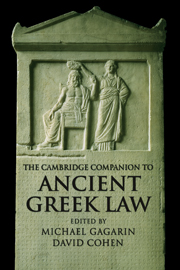Book contents
- Frontmatter
- Introduction
- Part 1: Law in Greece
- Part 2: Law in Athens I: Procedure
- Part 3: Law in Athens II: Substantive Law
- Part 4: Law outside Athens
- 16 The Gortyn Laws
- 17 Greek Law in Foreign Surroundings: Continuity and Development
- 18 Greek Law in the Hellenistic Period: Family and Marriage
- Part 5: Other Approaches to Greek Law
- Index
16 - The Gortyn Laws
from Part 4: - Law outside Athens
Published online by Cambridge University Press: 28 August 2006
- Frontmatter
- Introduction
- Part 1: Law in Greece
- Part 2: Law in Athens I: Procedure
- Part 3: Law in Athens II: Substantive Law
- Part 4: Law outside Athens
- 16 The Gortyn Laws
- 17 Greek Law in Foreign Surroundings: Continuity and Development
- 18 Greek Law in the Hellenistic Period: Family and Marriage
- Part 5: Other Approaches to Greek Law
- Index
Summary
Gortyn, like the rest of classical Crete, presents a paradox. Though we know little of its history in the archaic and classical periods from literary sources, and though we know virtually nothing about individuals, the exceptional richness of its legal inscriptions has made the city a prime focus of attention for historians both of Greek law and of Greek society. Yet, although no survey of Greek law can neglect these texts, they present intractable problems. Above all, there is no indigenous non-legal material. Apart from the imaginary southern Cretan landscape and lawscape depicted in Plato's Laws (Morrow 1960), we have only a few pages' worth of literary descriptions, made mostly by non-Cretans. The virtual silence of the historians is broken only by a long fragment of Ephoros (FGrH 70 F 149), an analytical passage of Aristotle's Politics (II 10, 1271b20-1272b23) and some excerpts of very uneven quality from later historians, Cretan and other. This evidence has major weaknesses.
- Type
- Chapter
- Information
- The Cambridge Companion to Ancient Greek Law , pp. 305 - 327Publisher: Cambridge University PressPrint publication year: 2005
- 8
- Cited by

